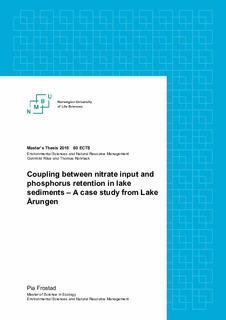| dc.contributor.advisor | Riise, Gunnhild | |
| dc.contributor.advisor | Rohrlack, Thomas | |
| dc.contributor.author | Frostad, Pia | |
| dc.coverage.spatial | Norway, Ås | nb_NO |
| dc.date.accessioned | 2018-09-30T13:22:30Z | |
| dc.date.available | 2018-09-30T13:22:30Z | |
| dc.date.issued | 2018 | |
| dc.identifier.uri | http://hdl.handle.net/11250/2565314 | |
| dc.description.abstract | Cultural eutrophication represents one of the greatest threats to freshwater systems, with lowland streams and lakes being especially vulnerable in areas that receive an increased supply of nutrients from human activity. Internal phosphorus loading can cause implications in the restoration of a lake that suffer from the detrimental effects of eutrophication, delaying the time from implementation of restorative actions to significant improvement over a period of several years. The presence of nitrate in the hypolimnion during summer stagnation can act as a phosphate buffer by suppressing the internal loading of phosphorus. Thus, establishing a relationship between the concentration of nitrate in the hypolimnion and internal loading of phosphate is a key factor in mediating the potential detrimental effects of eutrophication in a lake. In situ and laboratory analyses on water samples collected from the eutrophic, dimictic Lake Årungen in 2017, 2013 and 2009 were used to investigate the coupling between nitrate and phosphorus, and to what extent nitrate input from the catchment affects nitrates ability to control internal phosphorus loading in lake. Results from this study show that there was a coupling between nitrate and phosphate concentrations in the hypolimnion during anoxic conditions. In 2017 the nitrate levels were sufficiently high in protecting the lake from internal phosphorus loading. In 2013 and 2009, nitrate levels were depleted before the fall turnover, resulting in extensive leaking of phosphate from the sediment. With a nitrate decomposition rate of 0.02 mg/l a day above the sediment, a 50% reduction in the external input of nitrate in 2017 could have produced a similar outcome to what was seen in 2013 and 2009. Based on results from this study, attention should be focused on the start concentration of nitrate above the sediment at the onset of anoxic conditions in the hypolimnion. One should be cautious against measures that can potentially decrease the external input of nitrate to Lake Årungen, as this can, under given conditions, initiate internal phosphorus loading. | nb_NO |
| dc.language.iso | eng | nb_NO |
| dc.publisher | Norwegian University of Life Sciences, Ås | nb_NO |
| dc.rights | Attribution-NonCommercial-NoDerivatives 4.0 Internasjonal | * |
| dc.rights.uri | http://creativecommons.org/licenses/by-nc-nd/4.0/deed.no | * |
| dc.subject | Eutrophication | nb_NO |
| dc.subject | Internal phosphorus loading | nb_NO |
| dc.subject | Nitrate | nb_NO |
| dc.subject | Phosphate | nb_NO |
| dc.subject | Lake sediments | nb_NO |
| dc.subject | Årungen | nb_NO |
| dc.title | Coupling between nitrate input and phosphorus retention in lake sediments : a case study from Lake Årungen | nb_NO |
| dc.type | Master thesis | nb_NO |
| dc.description.version | submittedVersion | nb_NO |
| dc.subject.nsi | VDP::Matematikk og Naturvitenskap: 400 | nb_NO |
| dc.description.localcode | M-ECOL | nb_NO |

